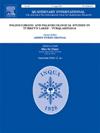Debris production, transport, and sedimentation at high fluid pressures in subglacial conduits
IF 1.9
3区 地球科学
Q3 GEOGRAPHY, PHYSICAL
引用次数: 0
Abstract
We lack robust criteria to identify where and when subglacial fluid pressures exceeded ice overburden pressure during debris production, transport, and deposition at former ice sheet beds. In this study, we use hydraulic damage as a marker for locations where overpressure (Pw ≥ Pi) developed. We focus on former subglacial conduits in Uppland, east-central Sweden, which represent Röthlisberger, Nye, and Hooke channels and lie on the floors of kilometre-wide subglacial meltwater corridors. The conduit floors show examples of hydrofracture, hydraulic jacking, and hydraulic bursting, with pervasive brecciation and fracture fill. Previous work has shown that subglacial rock hydrofracture requires fluid pressures greater than ice-overburden pressure to overcome the tensile strengths of old fractures (≤0.7 MPa) and of unfractured Precambrian gneisses (>8 MPa). Critically, at our sites, hydraulic damage was generated during high energy mass and fluid flows. In subglacial meltwater corridors, decimetre to metre depth sheetflow was initially dominant, with concentration of flow in broad, shallow H-channels. Hydraulic damage in rock was accompanied by till dilation and fluidisation, with pressure driven debris flows. In R- and N-channels, we identify distinctive sedimentary features that developed as conduits opened under overpressured pipeflow. These include high rubble concentrations that were sourced from the disintegration of underlying bedrock, rubble diamictons or poorly sorted and matrix-supported gravels interpreted as short-lived debris flows, coupled debris-hyperconcentrated flows, transport of large boulders under buoyancy, fluid escape structures, and sediment freezing due to instantaneous decompression. Similar assemblages of hydraulic damage and sedimentary features record the arrival and passage of pressurised subglacial flood waves and the concentration of sheetflow into conduits during historic jökulhaups. Major subglacial floods developed in Uppland during rapid final melt of the last Fennoscandian Ice Sheet in the early Holocene. We find that transient high subglacial fluid pressures contributed significantly to (i) the production of fresh rock debris, (ii) the erosion and recycling of till, and (iii) the transport and deposition of dense slurries in subglacial conduits.
求助全文
约1分钟内获得全文
求助全文
来源期刊

Quaternary International
地学-地球科学综合
CiteScore
5.60
自引率
4.50%
发文量
336
审稿时长
3 months
期刊介绍:
Quaternary International is the official journal of the International Union for Quaternary Research. The objectives are to publish a high quality scientific journal under the auspices of the premier Quaternary association that reflects the interdisciplinary nature of INQUA and records recent advances in Quaternary science that appeal to a wide audience.
This series will encompass all the full spectrum of the physical and natural sciences that are commonly employed in solving Quaternary problems. The policy is to publish peer refereed collected research papers from symposia, workshops and meetings sponsored by INQUA. In addition, other organizations may request publication of their collected works pertaining to the Quaternary.
 求助内容:
求助内容: 应助结果提醒方式:
应助结果提醒方式:


